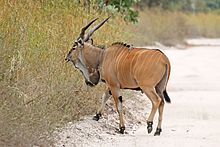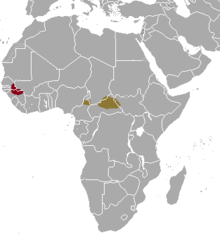
Back علند عملاق Arabic ايلاند عملاق ARZ БакътӀерхьул канна AV Frempol (Taurotragus derbianus) AVK Гигантска антилопа кана Bulgarian Antilopenn-eland veur Breton Eland de Derby Catalan Taurotragus derbianus CEB Antilopa Derbyho Czech Riesen-Elenantilope German
| Giant eland | |
|---|---|

| |
| T. d. derbianus Senegal | |

| |
| T. d. gigas at the Cincinnati Zoo | |
| Scientific classification | |
| Domain: | Eukaryota |
| Kingdom: | Animalia |
| Phylum: | Chordata |
| Class: | Mammalia |
| Order: | Artiodactyla |
| Family: | Bovidae |
| Subfamily: | Bovinae |
| Genus: | Taurotragus |
| Species: | T. derbianus
|
| Binomial name | |
| Taurotragus derbianus (J.E. Gray, 1847)
| |
| Subspecies | |
| |

| |
| Distribution of giant eland subspecies: Western giant eland Eastern giant eland | |
| Synonyms | |
|
Species synonymy[2]
| |
The giant eland (Taurotragus derbianus), also known as the Lord Derby's eland and greater eland, is an open-forest and savanna antelope. A species of the family Bovidae and genus Taurotragus, it was described in 1847 by John Edward Gray. The giant eland is the largest species of antelope, with a body length ranging from 220–290 cm (87–114 in). There are two subspecies: T. d. derbianus and T. d. gigas.
The giant eland is a herbivore, eating grasses, foliage and branches. They usually form small herds consisting of 15–25 members, both males and females. Giant elands are not territorial, and have large home ranges. They are naturally alert and wary, which makes them difficult to approach and observe. They can run at up to 70 km/h (43 mph) and use this speed as a defence against predators. Mating occurs throughout the year but peaks in the wet season. They mostly inhabit broad-leafed savannas, woodlands and glades.
The giant eland is native to Cameroon, Central African Republic, Chad, Democratic Republic of the Congo, Guinea, Mali, Senegal, and South Sudan. It is no longer present in The Gambia, Ghana, Ivory Coast, and Togo. It can also be found in the Jos wildlife park in Nigeria, Guinea-Bissau, and Uganda. The subspecies have been listed with different conservation statuses by the International Union for Conservation of Nature (IUCN).
- ^ IUCN SSC Antelope Specialist Group (2017). "Tragelaphus derbianus". IUCN Red List of Threatened Species. 2017: e.T44172A50197518. doi:10.2305/IUCN.UK.2017-2.RLTS.T44172A50197518.en. Retrieved 12 January 2018. Database entry includes a brief justification of why this species is of vulnerable.
- ^ Cite error: The named reference
MSW3was invoked but never defined (see the help page).
